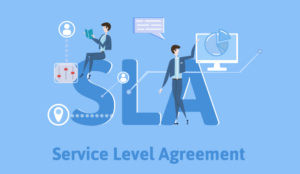Unsure of how to start a call centre?
If so, our checklist will help you to setup your ideal call centre, detailing the requirements your business needs to consider when starting from scratch.
People
Agents: the most important element of a contact centre!
Agents’ health and safety is paramount. Ensure they have an ergonomic workstation to minimise work-related muscle strain and health issues: a height adjustable desk and chair, ergonomic keyboard and mouse and a headset for hands-free productivity all aid in this area. Ensure this area regularly receives a health and safety assessment to ensure it adheres to specifications.
Looking after agents is key to a happy, productive workforce where results are high and attrition is low.
Recruitment
Consider whether you are easily able to recruit in the area you plan to locate your contact centre. Who are your competitors in terms of recruiting agents and what financial benefits are they offering, and does this fit with your business model requirements? Remember to consider not just agents, but the specific skillset for the roles you need and what transport links are available.
Process
Business processes
Review the business processes for your contact centre. Are they already documented and the processes mapped or are these being written from scratch? If they are yet to be defined, then now is the time to get them right. The accuracy and effectiveness of these will critically impact all further decisions that need to be made around staffing and software/infrastructure requirements.
Getting this right is difficult but worth every minute spent on it. Whatever your processes, use a good, flexible call scripting/CRM tool to map them, integrate all back-office and legacy systems into a coherent flow and then deliver them to agents from day one. It will save you a fortune in training and will also remove a lot of uncertainty and teething problems when you go live.
Integrate with your website
Crucially, ensure that your call centre is fully integrated with your website, or any website that may be important to your activity (such as price comparison sites, Google services, your clients’ websites, etc.). For instance, it is crucial that the systems you put in place have the ability to expose and consume web services with little or no need for bespoke software development.
Social business
Be open for social business from day one. The way in which customers choose to communicate is changing, which means that contact centres must be flexible in how they interact with customers. Multichannel functionality allows agents to respond to voice, email, social media, Chat, SMS and web “call me” requests, all within the same application.
Technology
Think cloud
A cloud-based contact centre infrastructure which fits your business model combines the benefits of a traditional on-premise solution with the flexibility, cost efficiency and multichannel capability provided by the scalability of a hosted solution.
Software
You need to consider what applications are required to support your business processes. Think about whether hosted in a cloud or desktop based is the right decision for your contact centre. Also, for systems that contain customer data (and perhaps card-holder data), you need to ensure that the required level of compliance can be achieved around Data Protection and PCI.
Speed of change
If speed of change is important to your contact centre, how much control do you need to maintain? If you are relying on external suppliers to deliver elements of change, ensure that they have the resources and skills to meet your needs in a timely fashion.
Headsets
Headsets are essential for all agents, so, where possible, purchase noise-cancelling headsets as they block out background noise. Wireless headsets facilitate freedom of movement, and as the DECT density can be set on each headset for your specific environment, larger contact centres can still use this type of device. Duo headsets are also a useful option to block out noise and allow agents to focus on their calls.
A supervisor cable is a useful and cost-effective device that allows managers to listen in on calls for training purposes. Noise at work protection is another necessary precaution that should be taken when setting up a contact centre, so look for EU Control of Noise at Work compliant audio devices.
Collaboration
Remember collaboration is coming. The ability to automate business processes and integrate with collaboration tools such as Microsoft® Exchange, Microsoft® Lync and IBM Sametime are critical in today’s world of collaboration.
Location
Location independent
Try to separate the technology from the location(s) of your operation. Setting up telephony and systems in a private cloud with non-geographical numbers and centralised delivery of systems such as ACD, dialler, scripting, CRM, etc. are good decisions to make. The future is an uncertain place and the ability to be agile, add new locations, outsource when appropriate and allow for growth are the things which a separation of call centre and technology will give you.
Cloud-based contact centres are location independent, which means that agents and administrators have the freedom to log in from any location. All that is required is a phone line (PSTN, SIP or mobile) and an internet connection.
Environment
Pay attention to the office layout to create a healthy working environment
Using the full space to disperse agents so they are not all sitting together creating a hub of noise will help to support a more positive sound environment.
Pay attention to placement of equipment such as printers and photocopiers, as the noise they generate can increase general office noise levels.
Add sound barriers between agents to soften the ambient office noise.
Other cost-effective steps that can be utilised to support this include using soft furnishings where possible, such as blinds, carpets, cushions and padded chairs. Plants also help to absorb sound within office environments.
Where possible, provide ‘break out’ areas for calls that require privacy or extra concentration. These can also be used for team meetings or one-to-one sessions.
Get your phone connections in early
Try to choose and order your ISDN and broadband connections as early as possible. Whatever supplier you end up going with, the lead times are going to be long. This is because behind the scenes, BT, Virgin, C&W and a handful of other large and slow telecom suppliers are still the only providers of lines and they take months to deliver. Don’t leave it to the last minute as this may delay your launch by weeks, if not months.
Plan for the future
Build for now but plan for the future. Every modern contact centre needs to scale and seamlessly grow to cost effectively react to market changes. The ability to add agents across centralised or distributed locations can make the difference between success and failure when responding to customer demand.
Management information
Make sure you have lots of management information, live monitoring and performance reports from day one. It is important that your information is current, accurate and easy to understand. Telephony stats are not enough. You will need to be able to link telephony data to the content of calls. This is another good reason to use scripted processes as these will add meaning to your statistics and allow you to fine-tune your operation.
To find out how to tie this altogether into a business plan, read our article: How to Write a Call Centre Business Plan
Contributors

Sian Ciabattoni, Andrew Doyle, Danny Singer and Klaas van der Leest.
Special thanks to Sian Ciabattoni, Marketing Director – Noble Systems EMEA; Andrew Doyle, Managing Director – Jabra Business Solutions, UK & Ireland; Danny Singer – Founder & CEO of Noetica; Klaas van der Leest, UK Managing Director – Intelecom.
Author: Megan Jones
Published On: 25th May 2016 - Last modified: 19th Feb 2021
Read more about - Customer Service Strategy, Customer Service, Jabra, Noble Systems, Puzzel, Setup




































I’m looking to open a call Centre soon
With love to learn if any one in South Africa can help